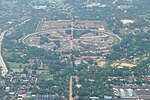Insein Township
Insein Township (Burmese: အင်းစိန်မြို့နယ်, pronounced [ɪ́ɰ̃sèiɰ̃ mjo̰nɛ̀]) is located in northern Yangon. The township comprises 21 wards, and shares borders with Shwepyitha township in the north, Hlaingthaya township in the west, Mingaladon township in the east and Mayangon township in the south. Insein is home to the Insein Prison, the most notorious prison in the country that houses hundreds of political prisoners. Until the 1990s, Insein, about 20 miles (32 km) from central Yangon, was beyond Yangon's city limits although by the 1980s, Insein was already integrated with the rest of the city. With the expansion of Yangon's city limits in the 1990s which also included founding new satellite towns, Insein was formally incorporated into Yangon.
Excerpt from the Wikipedia article Insein Township (License: CC BY-SA 3.0, Authors).Insein Township
Bayint Naung Road, Yangon Insein
Geographical coordinates (GPS) Address Nearby Places Show on map
Geographical coordinates (GPS)
| Latitude | Longitude |
|---|---|
| N 16.892777777778 ° | E 96.098055555556 ° |
Address
အင်းစိန်ထောင်
Bayint Naung Road
11111 Yangon, Insein
Yangon, Myanmar
Open on Google Maps




